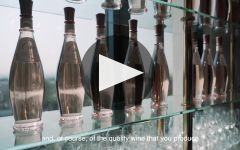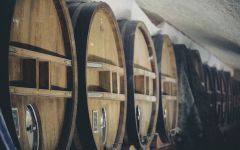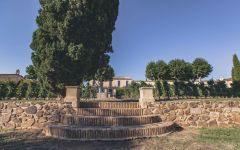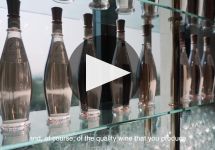Domaines Ott Clos Mireille Cotes de Provence Rose 2023
-
Wine
Enthusiast -
James
Suckling -
Wine
Spectator - Decanter



Product Details
Your Rating
Somm Note
Winemaker Notes
Seductive pale pink hue tinged with sandy gold. The nose is exquisitely delicate with notes of yellow fruit and acacia blossom. On the palate, the wine is invigorating, vivacious, with lingering aromas of yellow fruit delicately interwoven with the scent of melon. The soft, slightly spicy finish reveals intense notes of candied lemon peel.
Blend: 80% Grenache, 15% Cinsault, 5% Rolle
Professional Ratings
-
Wine Enthusiast
Bright and fresh aromas of peach, melon and violets immediately spring forward with notes of stone and earth in the background. This mouthfilling wine displays a wide range of complex flavors including grapefruit, pear, white strawberry, and jasmine, all supported by a earthy mineral base. The wine has yet to show off its true character and will be even better starting warmer months of 2025.
-
James Suckling
A delicious, well-rounded and tangy rosé exhibiting aromas of raspberries, candied berries and warm spices. It’s medium-bodied with fresh acidity. Succulent and tangy with a fruity finish.
-
Wine Spectator
Shows impressive power, offering red currant and juicy melon flavors powered by mouthwatering acidity and mineral energy. Dried rose petal and lavender accents add intrigue to the polished, silky palate, with the density and length making for a standout rose. Grenache, Cinsault and Syrah. Drink now through 2028. 1,200 cases imported.
-
Decanter
From one of the three Ott estates, with vineyards running down to the beach and cooled by maritime winds comes this palest of pale rosés. Starting delicately, before opening out to notes of orange, perfumed citrus, crunchy red berries, a taut, briney elegance and salted peaches. The saline minerality jostles with pretty but intense concentration and jubilant acidity. Perfumed, juicy and mouthwatering freshness with lovely varietal expression from this blend of Grenache, Cinsault and Rolle.
Other Vintages
2022- Vinous
-
Wine &
Spirits -
Wine
Enthusiast -
Wine
Spectator -
Robert
Parker - Decanter
-
Wine &
Spirits - Vinous
-
Wine
Spectator
-
Wine &
Spirits
- Vinous
-
Robert
Parker -
Wine
Enthusiast
-
Wine &
Spirits -
Robert
Parker
-
Robert
Parker
-
Wine
Enthusiast -
Wine &
Spirits
-
Wine
Enthusiast








In 1896, after a tour of France’s many vineyards, Marcel Ott, a young graduate in agronomy engineering, finally found an estate that inspired him. To set the scene, we are in Provence. The Mediterranean is lapping at the shore a mere stone’s throw away...
In these parts, growing vines is the legacy of ancient times. Alas, a short while before Marcel Ott’s discovery, phylloxera had wreaked havoc on the vines. The land was cheaper, but the vineyards would have to be replanted. The wine had lost a great deal of its soul in the vineyard’s reconstruction. Marcel Ott bought several estates and began renovating them with the determined ambition to create great Provencal wines from noble grape varieties.
Today, 120 years later, cousins Christian and Jean-François Ott dedicate their life to their ancestor’s love for the site. In 2004, Domaines Ott joined Louis Roederer and its fabulous selection of wine craftsmen.
Christian and Jean-François run three estates: Château de Selle, Clos Mireille (both Côtes de Provence) and Château Romassan (Bandol). Each of these properties has its own individual charm and personality. Each can be proud of their extremely elegant rosé, red and white wines.

Whether it’s playful and fun or savory and serious, most rosé today is not your grandmother’s White Zinfandel, though that category remains strong. Pink wine has recently become quite trendy, and this time around it’s commonly quite dry. Since the pigment in red wines comes from keeping fermenting juice in contact with the grape skins for an extended period, it follows that a pink wine can be made using just a brief period of skin contact—usually just a couple of days. The resulting color depends on grape variety and winemaking style, ranging from pale salmon to deep magenta.

More than just a European vacation hotspot and rosé capital of the world, Provence, in southeastern France, is a coastal appellation producing interesting wines of all colors. The warm, breezy Mediterranean climate is ideal for grape growing and the diverse terrain and soil types allow for a variety of wine styles within the region. Adjacent to the Rhône Valley, Provence shares some characteristics with this northwestern neighbor—namely, the fierce mistral wind and the plentiful wild herbs (such as rosemary, lavender, juniper and thyme) often referred to as garrigue. The largest appellation here is Côtes de Provence, followed by Coteaux d’Aix-en-Provence.
Provence is internationally acclaimed for dry, refreshing, pale-hued rosé wines, which make up the vast majority of the region’s production. These are typically blends, often dominated by Mourvèdre and supplemented by Grenache, Cinsault, Tibouren and other varieties.
A small amount of full-bodied, herbal white wine is made here—particularly from the Cassis appellation, of Clairette and Marsanne. Other white varieties used throughout Provence include Roussane, Sémillon, Vermentino (known locally as Rolle) and Ugni Blanc.
Perhaps the most interesting wines of the region, however, are the red wines of Bandol. Predominantly Mourvèdre, these are powerful, structured, and ageworthy wines with lush berry fruit and savory characteristics of earth and spice.
